2007 ISUZU KB P190 cruise control
[x] Cancel search: cruise controlPage 1888 of 6020
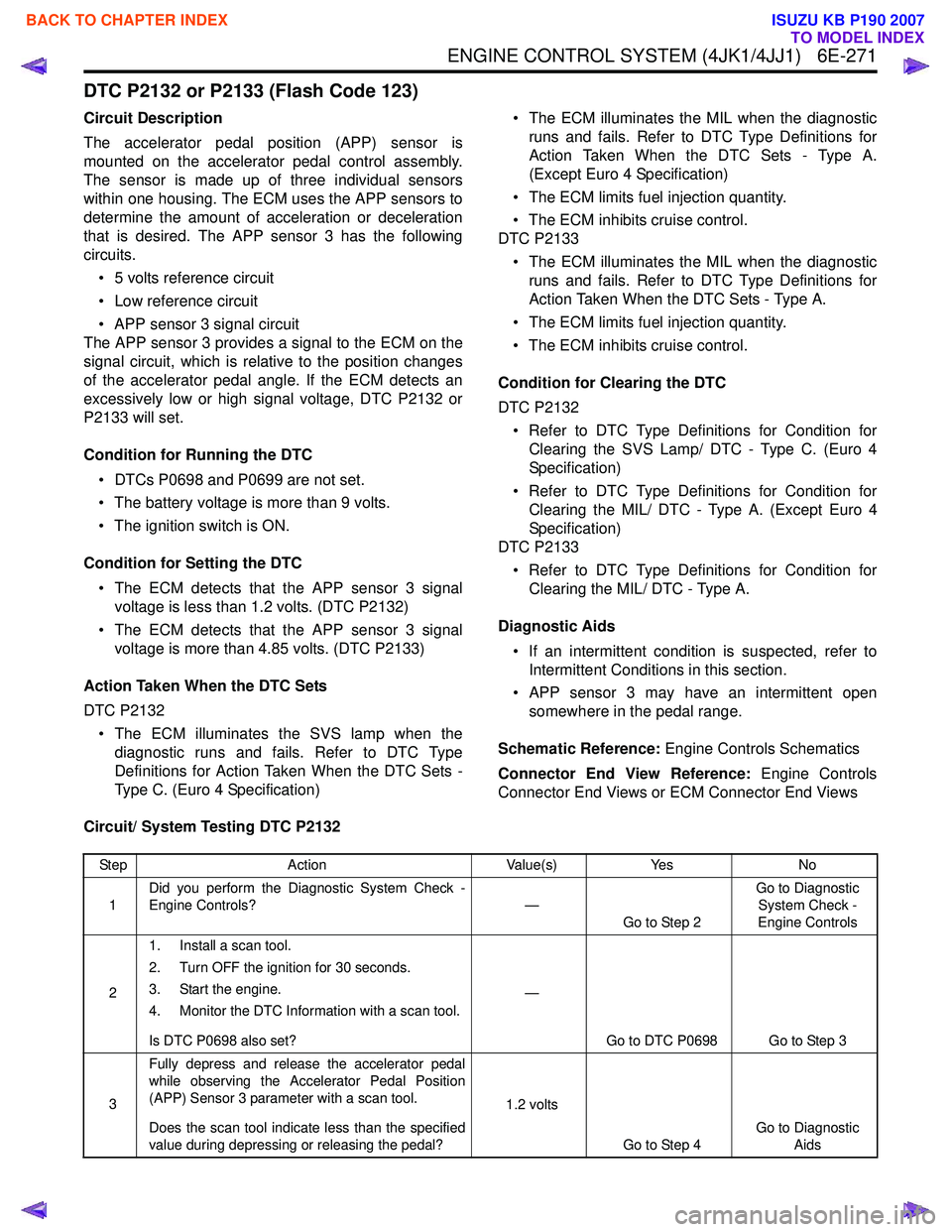
ENGINE CONTROL SYSTEM (4JK1/4JJ1) 6E-271
DTC P2132 or P2133 (Flash Code 123)
Circuit Description
The accelerator pedal position (APP) sensor is
mounted on the accelerator pedal control assembly.
The sensor is made up of three individual sensors
within one housing. The ECM uses the APP sensors to
determine the amount of acceleration or deceleration
that is desired. The APP sensor 3 has the following
circuits.
• 5 volts reference circuit
• Low reference circuit
• APP sensor 3 signal circuit
The APP sensor 3 provides a signal to the ECM on the
signal circuit, which is relative to the position changes
of the accelerator pedal angle. If the ECM detects an
excessively low or high signal voltage, DTC P2132 or
P2133 will set.
Condition for Running the DTC • DTCs P0698 and P0699 are not set.
• The battery voltage is more than 9 volts.
• The ignition switch is ON.
Condition for Setting the DTC • The ECM detects that the APP sensor 3 signal voltage is less than 1.2 volts. (DTC P2132)
• The ECM detects that the APP sensor 3 signal voltage is more than 4.85 volts. (DTC P2133)
Action Taken When the DTC Sets
DTC P2132 • The ECM illuminates the SVS lamp when the diagnostic runs and fails. Refer to DTC Type
Definitions for Action Taken When the DTC Sets -
Type C. (Euro 4 Specification) • The ECM illuminates the MIL when the diagnostic
runs and fails. Refer to DTC Type Definitions for
Action Taken When the DTC Sets - Type A.
(Except Euro 4 Specification)
• The ECM limits fuel injection quantity.
• The ECM inhibits cruise control.
DTC P2133
• The ECM illuminates the MIL when the diagnostic runs and fails. Refer to DTC Type Definitions for
Action Taken When the DTC Sets - Type A.
• The ECM limits fuel injection quantity.
• The ECM inhibits cruise control.
Condition for Clearing the DTC
DTC P2132 • Refer to DTC Type Definitions for Condition for Clearing the SVS Lamp/ DTC - Type C. (Euro 4
Specification)
• Refer to DTC Type Definitions for Condition for Clearing the MIL/ DTC - Type A. (Except Euro 4
Specification)
DTC P2133
• Refer to DTC Type Definitions for Condition for Clearing the MIL/ DTC - Type A.
Diagnostic Aids • If an intermittent condition is suspected, refer to Intermittent Conditions in this section.
• APP sensor 3 may have an intermittent open somewhere in the pedal range.
Schematic Reference: Engine Controls Schematics
Connector End View Reference: Engine Controls
Connector End Views or ECM Connector End Views
Circuit/ System Testing DTC P2132
Step Action Value(s)Yes No
1 Did you perform the Diagnostic System Check -
Engine Controls? —
Go to Step 2 Go to Diagnostic
System Check -
Engine Controls
2 1. Install a scan tool.
2. Turn OFF the ignition for 30 seconds.
3. Start the engine.
4. Monitor the DTC Information with a scan tool.
Is DTC P0698 also set? —
Go to DTC P0698 Go to Step 3
3 Fully depress and release the accelerator pedal
while observing the Accelerator Pedal Position
(APP) Sensor 3 parameter with a scan tool.
Does the scan tool indicate less than the specified
value during depressing or releasing the pedal? 1.2 volts
Go to Step 4 Go to Diagnostic
Aids
BACK TO CHAPTER INDEX
TO MODEL INDEX
ISUZU KB P190 2007
Page 1893 of 6020
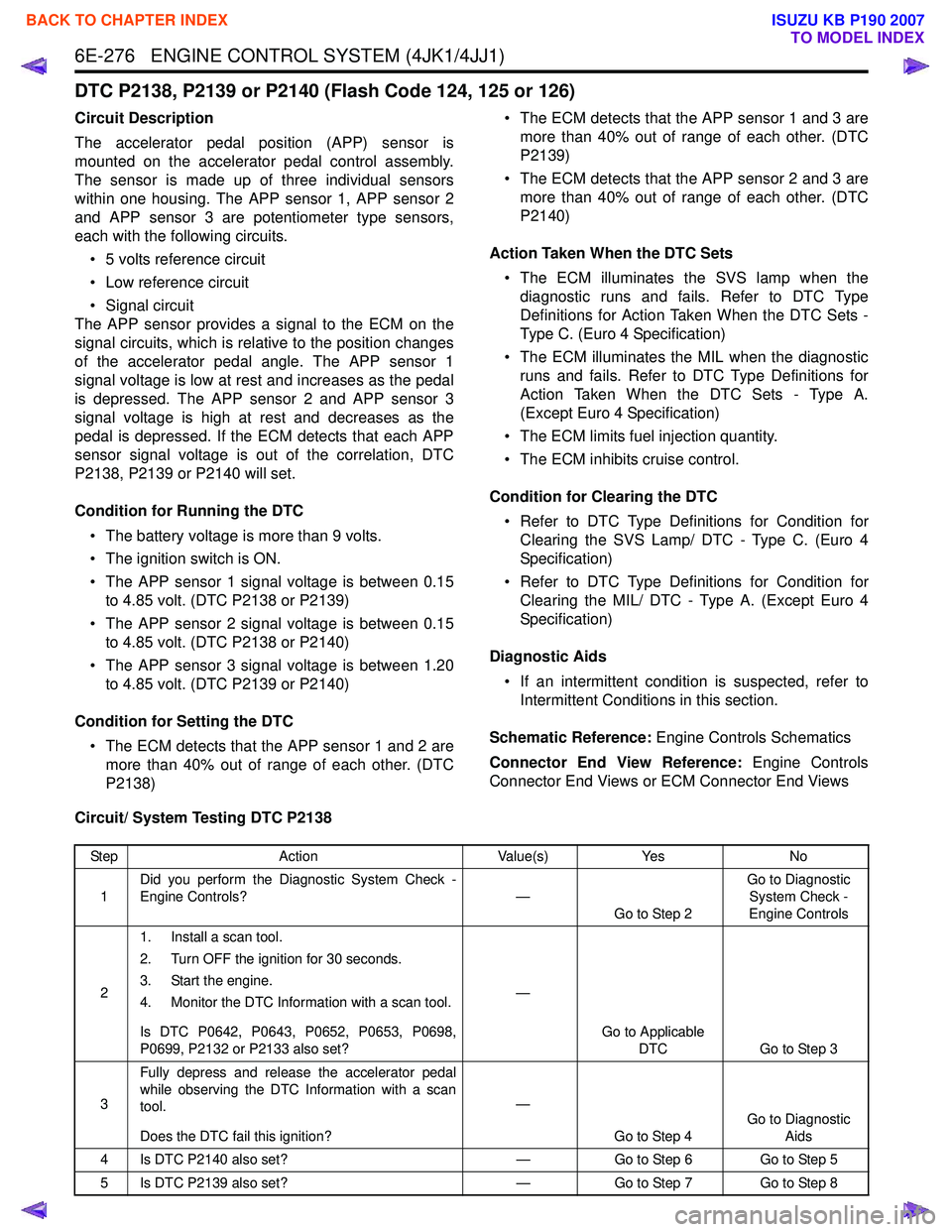
6E-276 ENGINE CONTROL SYSTEM (4JK1/4JJ1)
DTC P2138, P2139 or P2140 (Flash Code 124, 125 or 126)
Circuit Description
The accelerator pedal position (APP) sensor is
mounted on the accelerator pedal control assembly.
The sensor is made up of three individual sensors
within one housing. The APP sensor 1, APP sensor 2
and APP sensor 3 are potentiometer type sensors,
each with the following circuits.
• 5 volts reference circuit
• Low reference circuit
• Signal circuit
The APP sensor provides a signal to the ECM on the
signal circuits, which is relative to the position changes
of the accelerator pedal angle. The APP sensor 1
signal voltage is low at rest and increases as the pedal
is depressed. The APP sensor 2 and APP sensor 3
signal voltage is high at rest and decreases as the
pedal is depressed. If the ECM detects that each APP
sensor signal voltage is out of the correlation, DTC
P2138, P2139 or P2140 will set.
Condition for Running the DTC • The battery voltage is more than 9 volts.
• The ignition switch is ON.
• The APP sensor 1 signal voltage is between 0.15 to 4.85 volt. (DTC P2138 or P2139)
• The APP sensor 2 signal voltage is between 0.15 to 4.85 volt. (DTC P2138 or P2140)
• The APP sensor 3 signal voltage is between 1.20 to 4.85 volt. (DTC P2139 or P2140)
Condition for Setting the DTC • The ECM detects that the APP sensor 1 and 2 are more than 40% out of range of each other. (DTC
P2138) • The ECM detects that the APP sensor 1 and 3 are
more than 40% out of range of each other. (DTC
P2139)
• The ECM detects that the APP sensor 2 and 3 are more than 40% out of range of each other. (DTC
P2140)
Action Taken When the DTC Sets • The ECM illuminates the SVS lamp when the diagnostic runs and fails. Refer to DTC Type
Definitions for Action Taken When the DTC Sets -
Type C. (Euro 4 Specification)
• The ECM illuminates the MIL when the diagnostic runs and fails. Refer to DTC Type Definitions for
Action Taken When the DTC Sets - Type A.
(Except Euro 4 Specification)
• The ECM limits fuel injection quantity.
• The ECM inhibits cruise control.
Condition for Clearing the DTC • Refer to DTC Type Definitions for Condition for Clearing the SVS Lamp/ DTC - Type C. (Euro 4
Specification)
• Refer to DTC Type Definitions for Condition for Clearing the MIL/ DTC - Type A. (Except Euro 4
Specification)
Diagnostic Aids • If an intermittent condition is suspected, refer to Intermittent Conditions in this section.
Schematic Reference: Engine Controls Schematics
Connector End View Reference: Engine Controls
Connector End Views or ECM Connector End Views
Circuit/ System Testing DTC P2138
Step Action Value(s)Yes No
1 Did you perform the Diagnostic System Check -
Engine Controls? —
Go to Step 2 Go to Diagnostic
System Check -
Engine Controls
2 1. Install a scan tool.
2. Turn OFF the ignition for 30 seconds.
3. Start the engine.
4. Monitor the DTC Information with a scan tool.
Is DTC P0642, P0643, P0652, P0653, P0698,
P0699, P2132 or P2133 also set? —
Go to Applicable DTC Go to Step 3
3 Fully depress and release the accelerator pedal
while observing the DTC Information with a scan
tool.
Does the DTC fail this ignition? —
Go to Step 4 Go to Diagnostic
Aids
4 Is DTC P2140 also set? —Go to Step 6 Go to Step 5
5 Is DTC P2139 also set? —Go to Step 7 Go to Step 8
BACK TO CHAPTER INDEX
TO MODEL INDEX
ISUZU KB P190 2007
Page 1899 of 6020
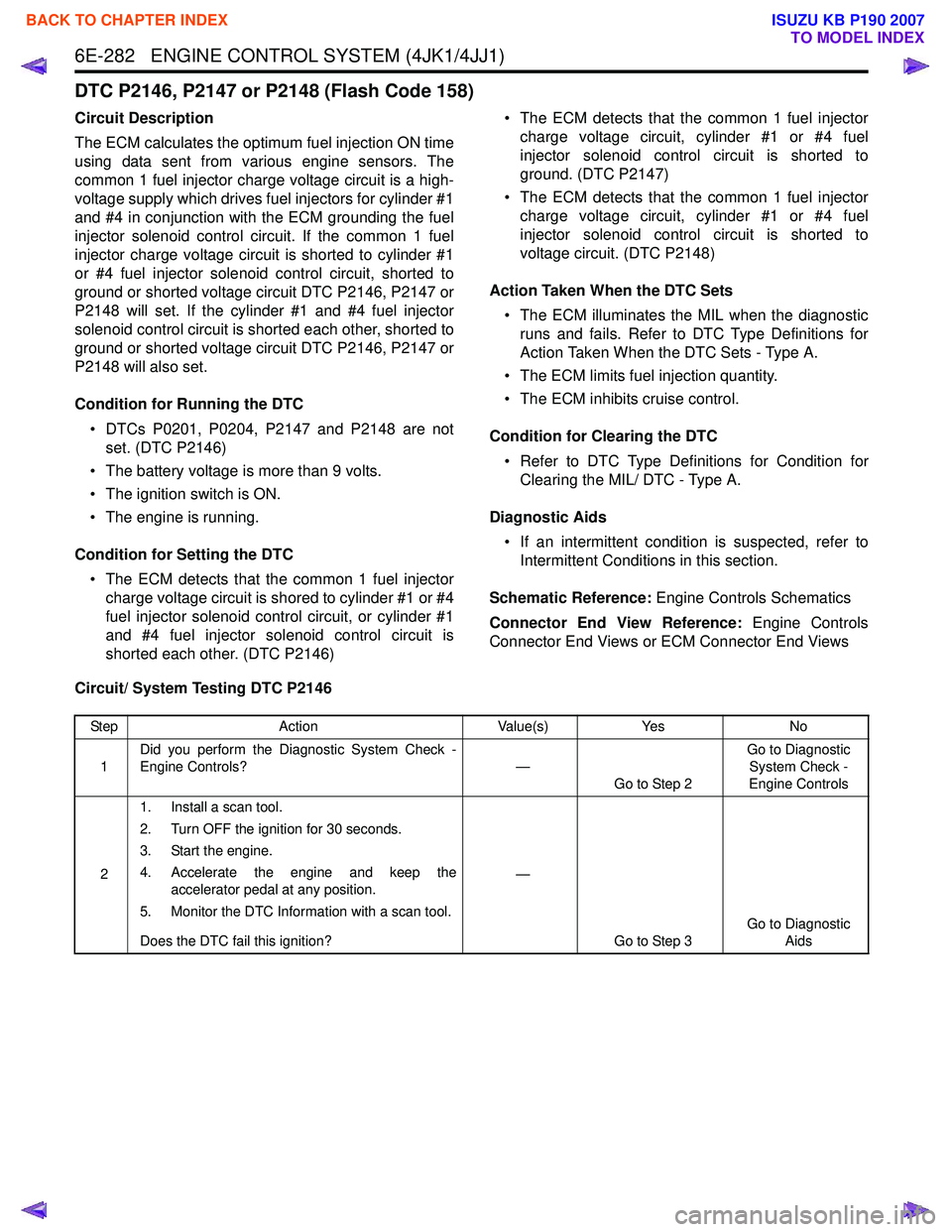
6E-282 ENGINE CONTROL SYSTEM (4JK1/4JJ1)
DTC P2146, P2147 or P2148 (Flash Code 158)
Circuit Description
The ECM calculates the optimum fuel injection ON time
using data sent from various engine sensors. The
common 1 fuel injector charge voltage circuit is a high-
voltage supply which drives fuel injectors for cylinder #1
and #4 in conjunction with the ECM grounding the fuel
injector solenoid control circuit. If the common 1 fuel
injector charge voltage circuit is shorted to cylinder #1
or #4 fuel injector solenoid control circuit, shorted to
ground or shorted voltage circuit DTC P2146, P2147 or
P2148 will set. If the cylinder #1 and #4 fuel injector
solenoid control circuit is shorted each other, shorted to
ground or shorted voltage circuit DTC P2146, P2147 or
P2148 will also set.
Condition for Running the DTC • DTCs P0201, P0204, P2147 and P2148 are not set. (DTC P2146)
• The battery voltage is more than 9 volts.
• The ignition switch is ON.
• The engine is running.
Condition for Setting the DTC • The ECM detects that the common 1 fuel injector charge voltage circuit is shored to cylinder #1 or #4
fuel injector solenoid control circuit, or cylinder #1
and #4 fuel injector solenoid control circuit is
shorted each other. (DTC P2146) • The ECM detects that the common 1 fuel injector
charge voltage circuit, cylinder #1 or #4 fuel
injector solenoid control circuit is shorted to
ground. (DTC P2147)
• The ECM detects that the common 1 fuel injector charge voltage circuit, cylinder #1 or #4 fuel
injector solenoid control circuit is shorted to
voltage circuit. (DTC P2148)
Action Taken When the DTC Sets • The ECM illuminates the MIL when the diagnostic runs and fails. Refer to DTC Type Definitions for
Action Taken When the DTC Sets - Type A.
• The ECM limits fuel injection quantity.
• The ECM inhibits cruise control.
Condition for Clearing the DTC • Refer to DTC Type Definitions for Condition for Clearing the MIL/ DTC - Type A.
Diagnostic Aids • If an intermittent condition is suspected, refer to Intermittent Conditions in this section.
Schematic Reference: Engine Controls Schematics
Connector End View Reference: Engine Controls
Connector End Views or ECM Connector End Views
Circuit/ System Testing DTC P2146
Step Action Value(s)Yes No
1 Did you perform the Diagnostic System Check -
Engine Controls? —
Go to Step 2 Go to Diagnostic
System Check -
Engine Controls
2 1. Install a scan tool.
2. Turn OFF the ignition for 30 seconds.
3. Start the engine.
4. Accelerate the engine and keep the accelerator pedal at any position.
5. Monitor the DTC Information with a scan tool.
Does the DTC fail this ignition? —
Go to Step 3 Go to Diagnostic
Aids
BACK TO CHAPTER INDEX
TO MODEL INDEX
ISUZU KB P190 2007
Page 1903 of 6020

6E-286 ENGINE CONTROL SYSTEM (4JK1/4JJ1)
DTC P2149, P2150 or P2151 (Flash Code 159)
Circuit Description
The ECM calculates the optimum fuel injection ON time
using data sent from various engine sensors. The
common 2 fuel injector charge voltage circuit is a high-
voltage supply which drives fuel injectors for cylinder #2
and #3 in conjunction with the ECM grounding the fuel
injector solenoid control circuit. If the common 2 fuel
injector charge voltage circuit is shorted to cylinder #2
or #3 fuel injector solenoid control circuit, shorted to
ground or shorted voltage circuit DTC P2149, P2150 or
P2151 will set. If the cylinder #2 and #3 fuel injector
solenoid control circuit is shorted each other, shorted to
ground or shorted voltage circuit DTC P2149, P2150 or
P2151 will also set.
Condition for Running the DTC • DTCs P0202, P0203, P2150 and P2151 are not set. (DTC P2149)
• The battery voltage is more than 9 volts.
• The ignition switch is ON.
• The engine is running.
Condition for Setting the DTC • The ECM detects that the common 2 fuel injector charge voltage circuit is shored to cylinder #2 or #3
fuel injector solenoid control circuit, or cylinder #2
and #3 fuel injector solenoid control circuit is
shorted each other. (DTC P2149). • The ECM detects that the common 2 fuel injector
charge voltage circuit, or cylinder #2 or #3 fuel
injector solenoid control circuit is shorted to
ground. (DTC P2150)
• The ECM detects that the common 2 fuel injector charge voltage circuit, or cylinder #2 or #3 fuel
injector solenoid control circuit is shorted to
voltage circuit. (DTC P2151)
Action Taken When the DTC Sets • The ECM illuminates the MIL when the diagnostic runs and fails. Refer to DTC Type Definitions for
Action Taken When the DTC Sets - Type A.
• The ECM limits fuel injection quantity.
• The ECM inhibits cruise control.
Condition for Clearing the DTC • Refer to DTC Type Definitions for Condition for Clearing the MIL/ DTC - Type A.
Diagnostic Aids • If an intermittent condition is suspected, refer to Intermittent Conditions in this section.
Schematic Reference: Engine Controls Schematics
Connector End View Reference: Engine Controls
Connector End Views or ECM Connector End Views
Circuit/ System Testing DTC P2149
Step Action Value(s)Yes No
1 Did you perform the Diagnostic System Check -
Engine Controls? —
Go to Step 2 Go to Diagnostic
System Check -
Engine Controls
2 1. Install a scan tool.
2. Turn OFF the ignition for 30 seconds.
3. Start the engine.
4. Accelerate the engine and keep the accelerator pedal at any position.
5. Monitor the DTC Information with a scan tool.
Does the DTC fail this ignition? —
Go to Step 3 Go to Diagnostic
Aids
BACK TO CHAPTER INDEX
TO MODEL INDEX
ISUZU KB P190 2007
Page 1907 of 6020
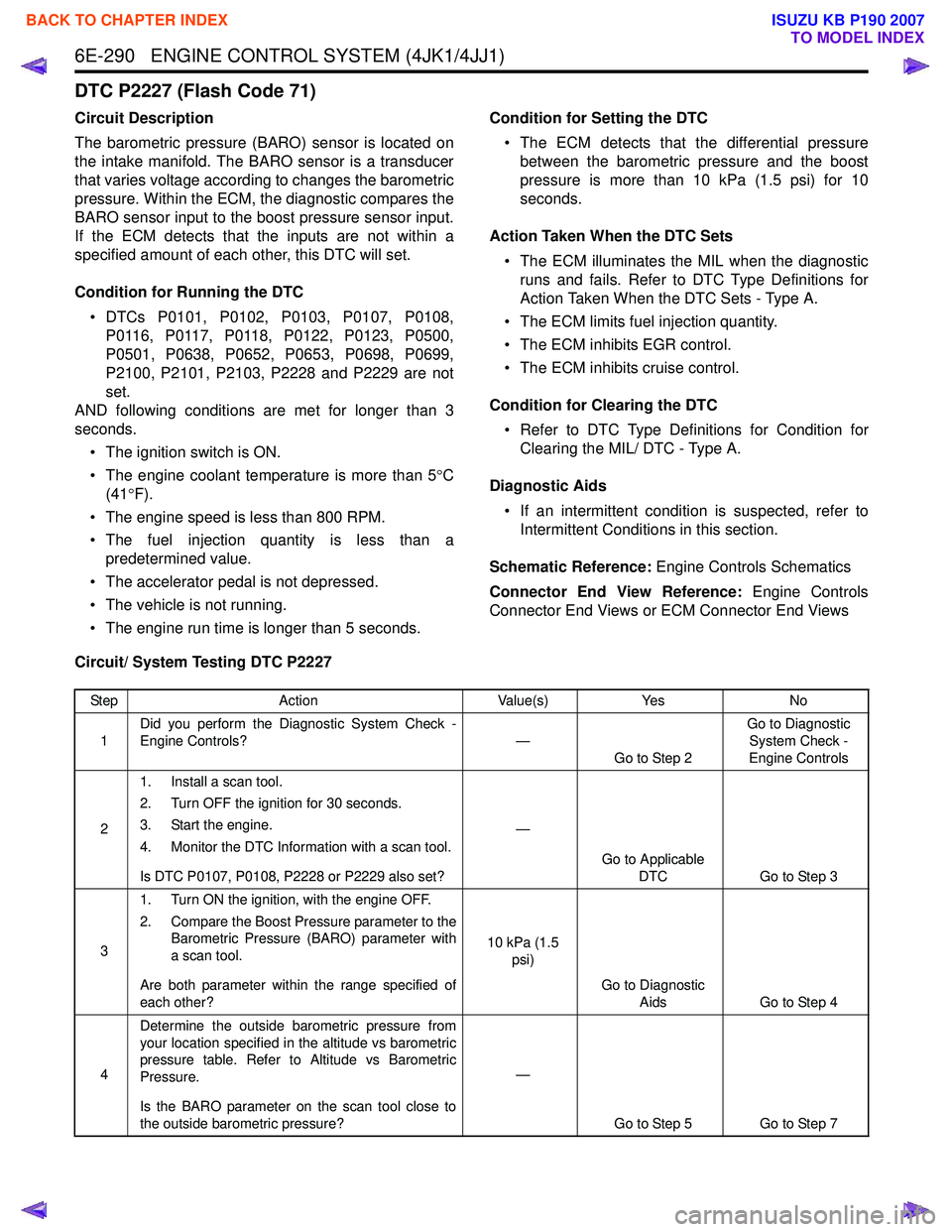
6E-290 ENGINE CONTROL SYSTEM (4JK1/4JJ1)
DTC P2227 (Flash Code 71)
Circuit Description
The barometric pressure (BARO) sensor is located on
the intake manifold. The BARO sensor is a transducer
that varies voltage according to changes the barometric
pressure. Within the ECM, the diagnostic compares the
BARO sensor input to the boost pressure sensor input.
If the ECM detects that the inputs are not within a
specified amount of each other, this DTC will set.
Condition for Running the DTC • DTCs P0101, P0102, P0103, P0107, P0108, P0116, P0117, P0118, P0122, P0123, P0500,
P0501, P0638, P0652, P0653, P0698, P0699,
P2100, P2101, P2103, P2228 and P2229 are not
set.
AND following conditions are met for longer than 3
seconds.
• The ignition switch is ON.
• The engine coolant temperature is more than 5 °C
(41 °F).
• The engine speed is less than 800 RPM.
• The fuel injection quantity is less than a predetermined value.
• The accelerator pedal is not depressed.
• The vehicle is not running.
• The engine run time is longer than 5 seconds. Condition for Setting the DTC
• The ECM detects that the differential pressure between the barometric pressure and the boost
pressure is more than 10 kPa (1.5 psi) for 10
seconds.
Action Taken When the DTC Sets • The ECM illuminates the MIL when the diagnostic runs and fails. Refer to DTC Type Definitions for
Action Taken When the DTC Sets - Type A.
• The ECM limits fuel injection quantity.
• The ECM inhibits EGR control.
• The ECM inhibits cruise control.
Condition for Clearing the DTC • Refer to DTC Type Definitions for Condition for Clearing the MIL/ DTC - Type A.
Diagnostic Aids • If an intermittent condition is suspected, refer to Intermittent Conditions in this section.
Schematic Reference: Engine Controls Schematics
Connector End View Reference: Engine Controls
Connector End Views or ECM Connector End Views
Circuit/ System Testing DTC P2227
Step Action Value(s)Yes No
1 Did you perform the Diagnostic System Check -
Engine Controls? —
Go to Step 2 Go to Diagnostic
System Check -
Engine Controls
2 1. Install a scan tool.
2. Turn OFF the ignition for 30 seconds.
3. Start the engine.
4. Monitor the DTC Information with a scan tool.
Is DTC P0107, P0108, P2228 or P2229 also set? —
Go to Applicable DTC Go to Step 3
3 1. Turn ON the ignition, with the engine OFF.
2. Compare the Boost Pressure parameter to the Barometric Pressure (BARO) parameter with
a scan tool.
Are both parameter within the range specified of
each other? 10 kPa (1.5
psi)
Go to Diagnostic Aids Go to Step 4
4 Determine the outside barometric pressure from
your location specified in the altitude vs barometric
pressure table. Refer to Altitude vs Barometric
Pressure.
Is the BARO parameter on the scan tool close to
the outside barometric pressure? —
Go to Step 5 Go to Step 7
BACK TO CHAPTER INDEX
TO MODEL INDEX
ISUZU KB P190 2007
Page 1910 of 6020

ENGINE CONTROL SYSTEM (4JK1/4JJ1) 6E-293
DTC P2228 or P2229 (Flash Code 71)
Circuit Description
The barometric pressure (BARO) sensor is located on
the intake manifold. The BARO sensor is a transducer
that varies voltage according to changes the barometric
pressure. The sensor has the following circuits.
• 5 volts reference circuit.
• Low reference circuit.
• BARO sensor signal circuit.
The BARO sensor provides a signal to the ECM on the
signal circuit, which is relative to the pressure changes
of the barometric pressure. The ECM should detect a
low signal voltage at a low barometric pressure, such
as high altitude place. The ECM should detect high
signal voltage at a high barometric pressure. The ECM
uses this voltage signal to calibrate the fuel injection
quantity and injection timing for altitude compensation.
If the ECM detects an excessively low or high signal
voltage, DTC P2228 or P2229 will set.
Condition for Running the DTC • DTCs P0652 and P0653 are not set.
• The battery voltage is more than 9 volts.
• The ignition switch is ON.
Condition for Setting the DTC • The ECM detects that the BARO sensor signal voltage is less than 0.1 volts for 3 seconds. (DTC
P2228) • The ECM detects that the BARO sensor signal
voltage is less than 4.3 volts for 3 seconds. (DTC
P2229)
Action Taken When the DTC Sets • The ECM illuminates the MIL when the diagnostic runs and fails. Refer to DTC Type Definitions for
Action Taken When the DTC Sets - Type A.
• The ECM uses a BARO substitution of default value.
• The ECM limits fuel injection quantity.
• The ECM inhibits EGR control.
• The ECM inhibits cruise control.
Condition for Clearing the DTC • Refer to DTC Type Definitions for Condition for Clearing the MIL/ DTC - Type A.
Diagnostic Aids • If an intermittent condition is suspected, refer to Intermittent Conditions in this section.
Schematic Reference: Engine Controls Schematics
Connector End View Reference: Engine Controls
Connector End Views or ECM Connector End Views
Circuit/ System Testing DTC P2228
Step Action Value(s)Yes No
1 Did you perform the Diagnostic System Check -
Engine Controls? —
Go to Step 2 Go to Diagnostic
System Check -
Engine Controls
2 1. Install a scan tool.
2. Turn OFF the ignition for 30 seconds.
3. Start the engine.
4. Monitor the DTC Information with a scan tool.
Is DTC P0652 also set? —
Go to DTC P0652 Go to Step 3
3 Observe the Barometric Pressure (BARO) Sensor
parameter with a scan tool.
Is the BARO Sensor parameter less than the
specified value? 0.1 volts
Go to Step 4 Go to Diagnostic
Aids
4 1. Turn OFF the ignition.
2. Disconnect the BARO sensor harness connector.
3. Connect a DMM between the 5 volts reference circuit (pin 3 of E-40) and a known good
ground.
4. Turn ON the ignition, with the engine OFF.
Is the DMM voltage more than the specified value? 4.7 volts
Go to Step 5 Go to Step 6
BACK TO CHAPTER INDEX
TO MODEL INDEX
ISUZU KB P190 2007
Page 1917 of 6020
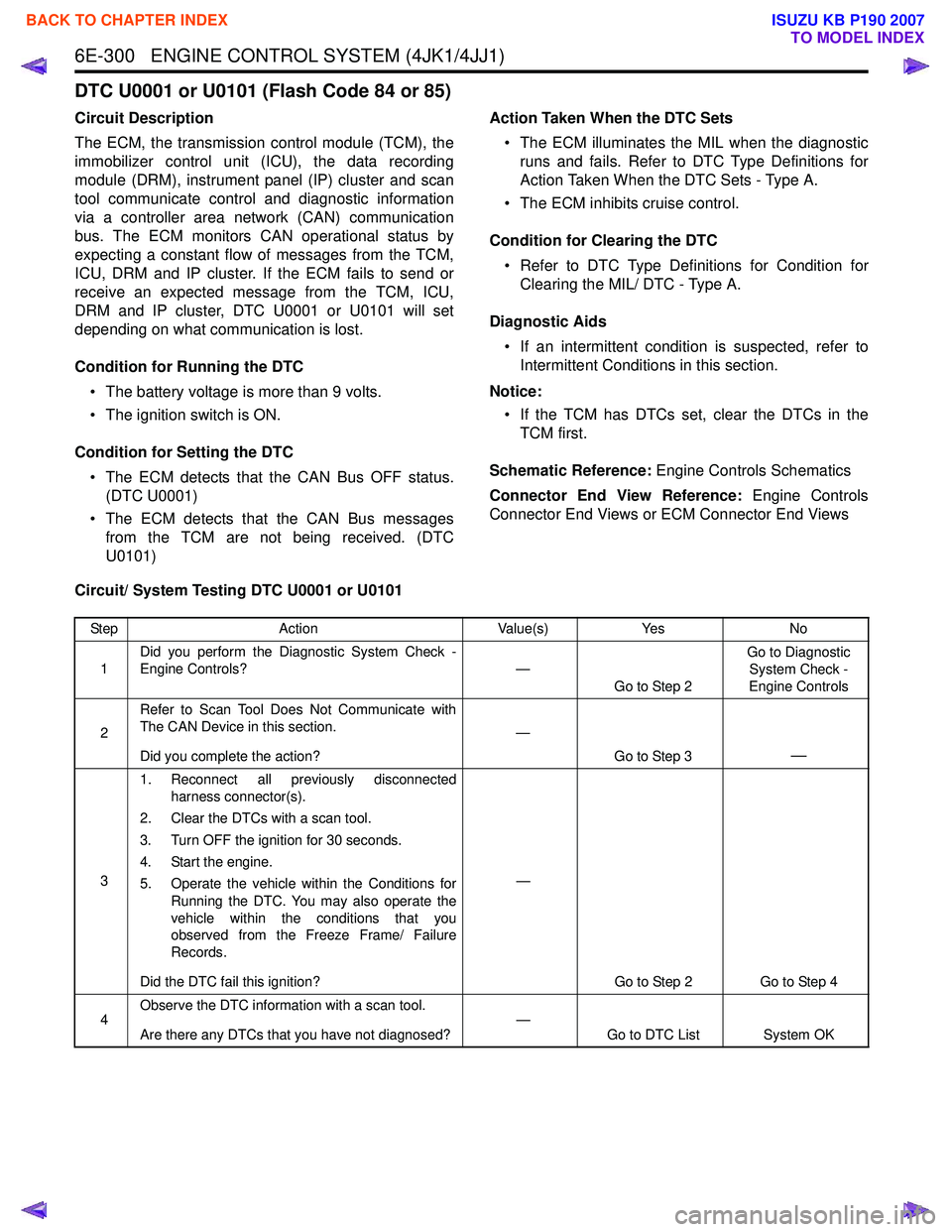
6E-300 ENGINE CONTROL SYSTEM (4JK1/4JJ1)
DTC U0001 or U0101 (Flash Code 84 or 85)
Circuit Description
The ECM, the transmission control module (TCM), the
immobilizer control unit (ICU), the data recording
module (DRM), instrument panel (IP) cluster and scan
tool communicate control and diagnostic information
via a controller area network (CAN) communication
bus. The ECM monitors CAN operational status by
expecting a constant flow of messages from the TCM,
ICU, DRM and IP cluster. If the ECM fails to send or
receive an expected message from the TCM, ICU,
DRM and IP cluster, DTC U0001 or U0101 will set
depending on what communication is lost.
Condition for Running the DTC • The battery voltage is more than 9 volts.
• The ignition switch is ON.
Condition for Setting the DTC • The ECM detects that the CAN Bus OFF status. (DTC U0001)
• The ECM detects that the CAN Bus messages from the TCM are not being received. (DTC
U0101) Action Taken When the DTC Sets
• The ECM illuminates the MIL when the diagnostic runs and fails. Refer to DTC Type Definitions for
Action Taken When the DTC Sets - Type A.
• The ECM inhibits cruise control.
Condition for Clearing the DTC • Refer to DTC Type Definitions for Condition for Clearing the MIL/ DTC - Type A.
Diagnostic Aids • If an intermittent condition is suspected, refer to Intermittent Conditions in this section.
Notice: • If the TCM has DTCs set, clear the DTCs in the TCM first.
Schematic Reference: Engine Controls Schematics
Connector End View Reference: Engine Controls
Connector End Views or ECM Connector End Views
Circuit/ System Testing DTC U0001 or U0101
Step Action Value(s)Yes No
1 Did you perform the Diagnostic System Check -
Engine Controls? —
Go to Step 2 Go to Diagnostic
System Check -
Engine Controls
2 Refer to Scan Tool Does Not Communicate with
The CAN Device in this section.
Did you complete the action? —
Go to Step 3
—
31. Reconnect all previously disconnected
harness connector(s).
2. Clear the DTCs with a scan tool.
3. Turn OFF the ignition for 30 seconds.
4. Start the engine.
5. Operate the vehicle within the Conditions for Running the DTC. You may also operate the
vehicle within the conditions that you
observed from the Freeze Frame/ Failure
Records.
Did the DTC fail this ignition? —
Go to Step 2 Go to Step 4
4 Observe the DTC information with a scan tool.
Are there any DTCs that you have not diagnosed? —
Go to DTC List System OK
BACK TO CHAPTER INDEX
TO MODEL INDEX
ISUZU KB P190 2007
Page 1931 of 6020
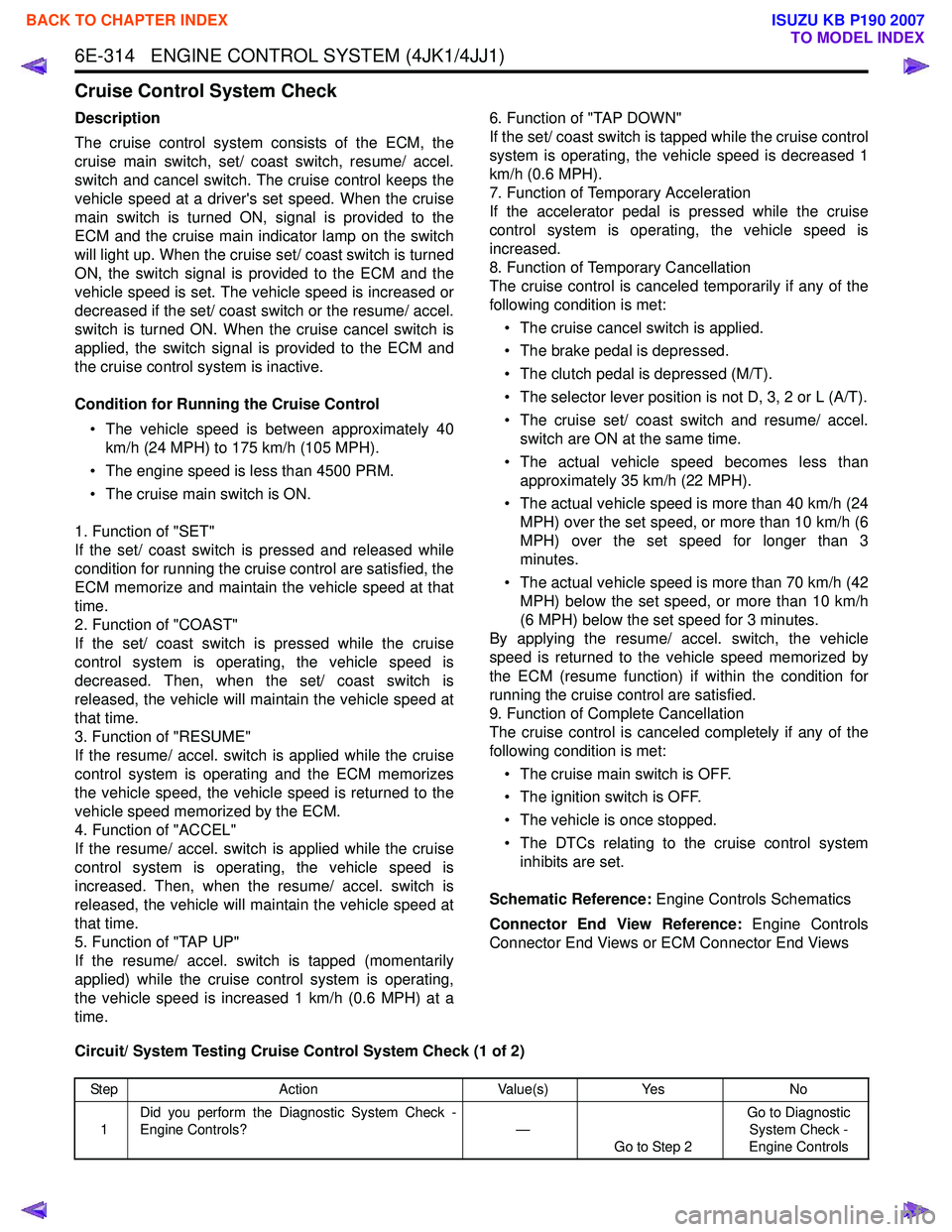
6E-314 ENGINE CONTROL SYSTEM (4JK1/4JJ1)
Cruise Control System Check
Description
The cruise control system consists of the ECM, the
cruise main switch, set/ coast switch, resume/ accel.
switch and cancel switch. The cruise control keeps the
vehicle speed at a driver's set speed. When the cruise
main switch is turned ON, signal is provided to the
ECM and the cruise main indicator lamp on the switch
will light up. When the cruise set/ coast switch is turned
ON, the switch signal is provided to the ECM and the
vehicle speed is set. The vehicle speed is increased or
decreased if the set/ coast switch or the resume/ accel.
switch is turned ON. When the cruise cancel switch is
applied, the switch signal is provided to the ECM and
the cruise control system is inactive.
Condition for Running the Cruise Control • The vehicle speed is between approximately 40 km/h (24 MPH) to 175 km/h (105 MPH).
• The engine speed is less than 4500 PRM.
• The cruise main switch is ON.
1. Function of "SET"
If the set/ coast switch is pressed and released while
condition for running the cruise control are satisfied, the
ECM memorize and maintain the vehicle speed at that
time.
2. Function of "COAST"
If the set/ coast switch is pressed while the cruise
control system is operating, the vehicle speed is
decreased. Then, when the set/ coast switch is
released, the vehicle will maintain the vehicle speed at
that time.
3. Function of "RESUME"
If the resume/ accel. switch is applied while the cruise
control system is operating and the ECM memorizes
the vehicle speed, the vehicle speed is returned to the
vehicle speed memorized by the ECM.
4. Function of "ACCEL"
If the resume/ accel. switch is applied while the cruise
control system is operating, the vehicle speed is
increased. Then, when the resume/ accel. switch is
released, the vehicle will maintain the vehicle speed at
that time.
5. Function of "TAP UP"
If the resume/ accel. switch is tapped (momentarily
applied) while the cruise control system is operating,
the vehicle speed is increased 1 km/h (0.6 MPH) at a
time. 6. Function of "TAP DOWN"
If the set/ coast switch is tapped while the cruise control
system is operating, the vehicle speed is decreased 1
km/h (0.6 MPH).
7. Function of Temporary Acceleration
If the accelerator pedal is pressed while the cruise
control system is operating, the vehicle speed is
increased.
8. Function of Temporary Cancellation
The cruise control is canceled temporarily if any of the
following condition is met:
• The cruise cancel switch is applied.
• The brake pedal is depressed.
• The clutch pedal is depressed (M/T).
• The selector lever position is not D, 3, 2 or L (A/T).
• The cruise set/ coast switch and resume/ accel. switch are ON at the same time.
• The actual vehicle speed becomes less than approximately 35 km/h (22 MPH).
• The actual vehicle speed is more than 40 km/h (24 MPH) over the set speed, or more than 10 km/h (6
MPH) over the set speed for longer than 3
minutes.
• The actual vehicle speed is more than 70 km/h (42 MPH) below the set speed, or more than 10 km/h
(6 MPH) below the set speed for 3 minutes.
By applying the resume/ accel. switch, the vehicle
speed is returned to the vehicle speed memorized by
the ECM (resume function) if within the condition for
running the cruise control are satisfied.
9. Function of Complete Cancellation
The cruise control is canceled completely if any of the
following condition is met:
• The cruise main switch is OFF.
• The ignition switch is OFF.
• The vehicle is once stopped.
• The DTCs relating to the cruise control system inhibits are set.
Schematic Reference: Engine Controls Schematics
Connector End View Reference: Engine Controls
Connector End Views or ECM Connector End Views
Circuit/ System Testing Cruise Control System Check (1 of 2)
Step Action Value(s)Yes No
1 Did you perform the Diagnostic System Check -
Engine Controls? —
Go to Step 2 Go to Diagnostic
System Check -
Engine Controls
BACK TO CHAPTER INDEX
TO MODEL INDEX
ISUZU KB P190 2007